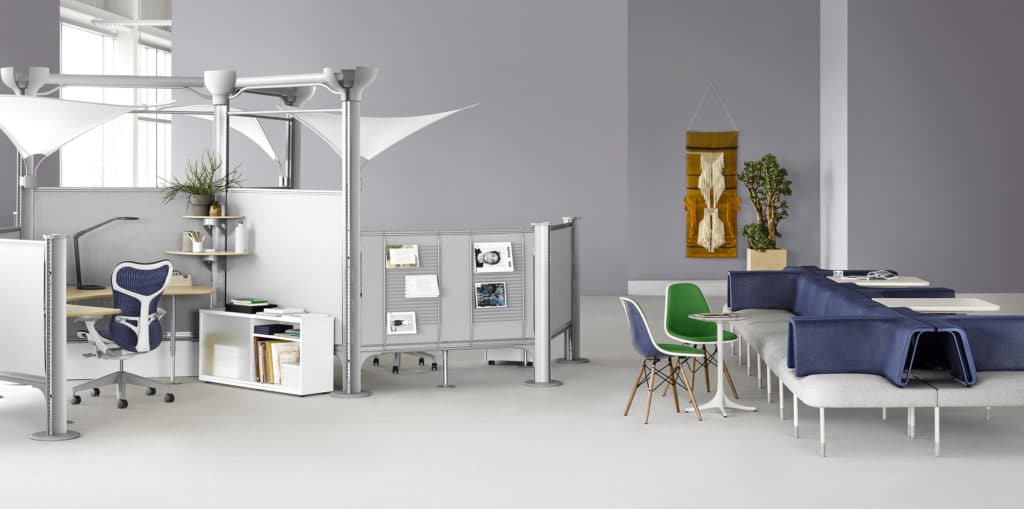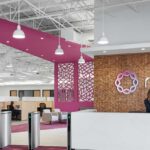Launchpad Academy put together a handy guide walking through the principles of design. However, they were looking at it in the context of homes. We thought we’d walk through them together and look at how each of those principles are applied in specifically in office settings.

Unity
All the elements used should complement one another and a smooth transition should exist from one to another. A good understanding of Alignment of objects, Similarity of color/pattern/texture, Proximity (spacing) of objects, Repetition (grouping) of elements based on similarity, Continuation and Overlapping of interior design elements are a few ways to achieve ‘Unity’ in an interior design arrangement.
Sometimes, things just feel right – that’s essentially the goal of the unity principle. When putting together a space, it’s important that all objects in a space simply feel right – and this principle quantifies that feeling. The texture, spacing, grouping, and continuation of objects, colors, and patterns should make a space feel put together, just so. You don’t want sameness – just picking one color and blindly sticking to it. You want unity, built from the repetition of a theme in new and creative ways.
Balance
Balance is only achieved when the visual weight of the elements are evenly distributed along a central axis or point that can be both real and imaginary. Balance can be achieved by three popular ways namely Symmetrical, Asymmetrical and Radial.
Balance helps ensure that a design doesn’t lean too far in any one particular direction. In photography, a photo is color-corrected when there’s true black and true white in the image, and no part of the image is so dark or so light that detail can’t be discerned. Balance works like that. If your design has a great deal of brightness, it’s important to balance that with something that’s dull. You don’t want all bright, all dark, all light. You want opposites to present themselves throughout your design.
Rhythm
The principle of Rhythm essentially suggests a connected movement between different elements of interior design. This movement is essential to maintain a visual tempo between elements that have different visual weights.
If you’re doing something just once in a design, the saying goes, you shouldn’t be doing it at all. You wouldn’t want one desk to be a different color than all of the others. Forcing something to stand out which doesn’t deserve emphasis feels random and garish. Instead, you want to build a rhythm, using the same things in multiple ways. If you’re using wood textures, you should be using them in several different ways throughout a complete office. Don’t do something once, and once only.
Emphasis
Elements like color, pattern and texture must be used to emphasize a particular focal point. In fact these elements must be used in such a way that the focal point dominates the rest of the décor items and pulls the room together. Other items that surround the focal point must complement the latter and share a contrast that puts the focal point in the top priority.
Newspaper design follows a very simple scheme – on every page, there should be exactly one image and one article which is more important than all the others. Designing an office, a table – really, designing just about anything follows that principle. It makes people comfortable to be told visually where they should look first. Centerpieces matter – and in every design, something should visually balance all the rest, serving as a focal point. The first thing you see when you walk into the room.
Emphasis matters in another important way as well. If you emphasize everything, you emphasize nothing. If you take a highlighter to every sentence on a page, you’ve not served to communicate anything through your effort. That’s why emphasis matters – it sets priorities, and often those are business priorities. Whether it’s the massive sign at the entrance to Facebook’s campus (built from hundreds of thousands of user images and strongly pushing a message of community), or the stark, clean lines of an Apple store, good design should send a message. Are you communicating what you intend to through your choices on what to emphasize?
Contrast
Contrast refers to the difference in the luminance or color of objects that differentiates them from one another. In interior design, contrast can be achieved by three elements namely color, form and space.
Contrast kills blandness. You wouldn’t ever design an office space fully from the color green. You’d need to set off that color with another. Likewise, you can’t use a metal texture on every surface. Both designs (even though a choice of metal might be an exciting one) will come off as bland, military, or more of the same. Contrast is what makes everything in your design visible. Don’t make the mistake of staying so true to your material or color selection that it’s not even noticeable (because there’s nothing setting it off).
Scale and Proportion
The principles of scale and proportion ensure that objects placed in a space look like they belong to each other. Be it the size, dimension, shape or color of the objects, a harmony should be established between them and a proportion has to be maintained.
There’s a saying the incomparable Douglas Adams popularized about Feng Shui and interior design. “What would a dragon like?” He says, essentially, there’s an art and a value to looking at design from another perspective. If a dragon were to walk around your office, would there still be a visual appeal to your design from its perspective?
Go back to the issue of how you figure out how a room or a house should be designed and instead of going through all the business of trying to work out the angles and trying to digest which genuine architectural principles you may want to take out of what may be a passing architectural fad, just ask yourself, ‘how would a dragon live here?’ We are used to thinking in terms of organic creatures; an organic creature may consist of an enormous complexity of all sorts of different variables that are beyond our ability to resolve but we know how organic creatures live. We’ve never seen a dragon but we’ve all got an idea of what a dragon is like, so we can say, ‘Well if a dragon went through here, he’d get stuck just here and a little bit cross over there because he couldn’t see that and he’d wave his tail and knock that vase over’. You figure out how the dragon’s going to be happy here and lo and behold! you’ve suddenly got a place that makes sense for other organic creatures, such as ourselves, to live in.
So, the next time you’re thinking about the proportions of various parts of your overall design, just think: “what would a dragon like?”
Details
Details are like cherries on an ice cream, they might seem extra but without cherries the ice cream isn’t just complete! Be it the small embroideries on a pillow cover or the color within those embroidery patterns, every detail adds a little bit of life to the overall interior design, adding their own distinctive feature to the overall composition.
A design without fine detail work seems not to have been designed at all. You wouldn’t go through the trouble of designing a company advertisement, then just print it out on whatever paper is lying around. A design isn’t finished until every t is crossed and every i dotted.



Leave a Reply